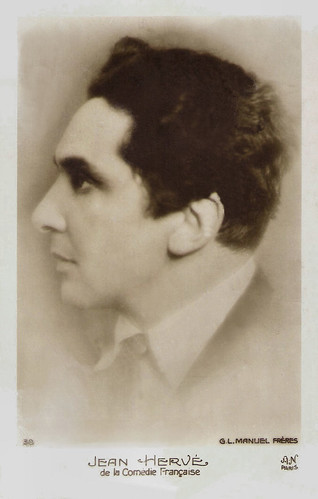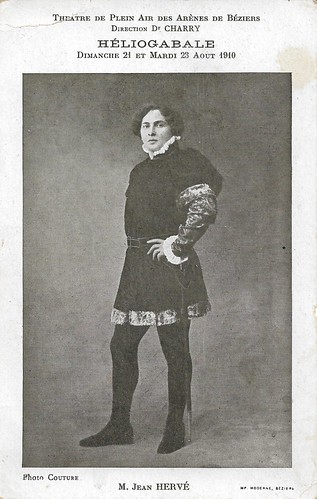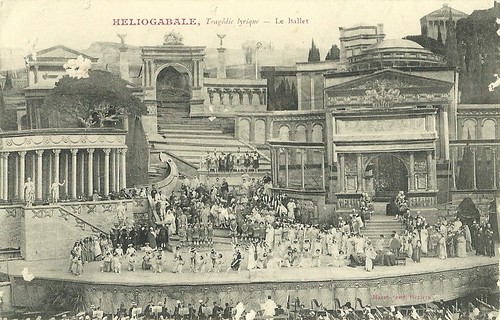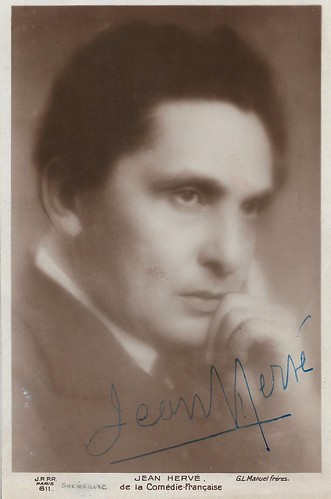Jean Hervé (1884-1966) was a French stage and screen actor, known for his work at the Comédie-Française but also for his parts in Film d'Art cinema, the Rocambole films, and such classics as La Terre (1921) and Feu Mathias Pascal (1926).

French postcard by A.N. (A. Noyer), Paris, no. 38. Photo: G.L. Manuel Frères. Jean Hervé de la Comédie Française.

French postcard in the Nos artistes dans leur loge series, no. 132. Photo: Comoedia.

French postcard, no. 103. On the back, the logo of postcard printer Guilleminot.
Jean Hervé was born in 1884 in Paris. He made his mark in 1910 with the open-air staging of the lyrical tragedy 'Héliogabale' by Déodat de Séverac at the Théâtre des Arènes in Béziers. While Edouard de Max had the lead, and René Alexandre played the hero Rusca who conquered the emperor, Hervé played his friend Claudius. The stage production was accompanied by many ballet acts.
In the early 1910s, Hervé worked for years at the Théâtre de l'Odéon, directed by André Antoine, Firmin Gémier and others. In 1919 he entered the Comédie-Française and between 1925 and 1941, he was Sociétaire there. After 1941 and until the early 1960s he acted at various theatres, in particular at the Théâtre Hébertot and the Odéon.
Jean Hervé also had a rich film career. In 1908 he debuted in the Lux production La fille du braconnier/The Poacher's Daughter (Gérard Bourgeois, 1908). From 1912 on, he acted in a few Film d'Art films. He was Nero in the Jean Racine adaptation Brittanicus (Camille de Morlhon, 1912), and Bassanio in the William Shakespeare adaption Shylock (Henri Desfontaines, 1913), starring Harry Baur and Pepa Bonafé.
He also acted in the Eclipse production La légende d'Oedipe/Oedipus Rex (Gaston Roudès, 1913), starring Mounet-Sully whose big stage role this had been. At Pathé Frères, Hervé also acted in modern drama: he had the lead in Trente ans ou la vie d'un joueur/Thirty Years of a Gambler's Life (Adrien Caillard, Georges Monca, 1912), about a young husband who falls in the clutches of an evil friend (Georges Tréville), who makes him gamble, wrecks his marriage and almost causes him to kill his own son.
Lacking at IMDb is the Pathé film La Closerie des genêts (Adrien Caillard, 1913), in which he acted opposite Léon Bernard and Sarah Davids, who also acted in the previous film. In 1914 Hervé had a major supporting part in the Pathé episode film Rocambole, shot in 1913 and released in 1914 subsequently as La Jeunesse de Rocambole/Rocambole, Les Exploits de Rocambole/Le Nouveau Rocambole, and Rocambole et l'héritage du marquis de Morfontain. The films were based on the work by Pierre Alexis de Ponson du Terrail, and directed by Georges Denola. While Gaston Silvestre played the title role, Hervé played Armand de Kergaz, Andrée Pascal his wife, Madeleine Céliat was Baccarat, and Tréville co-acted in this film too.

French postcard by MP Moderne, Béziers. Photo: Couture. Jean Hervé in the play 'Héliogabale', directed by Joseph Charry, at the open air Théâtre des Arènes in Béziers on 21 and 23 August 1910.

French postcard. Ballet of the lyrical tragedy 'Héliogabale', on 21 and 23 August 1910 at the Théàtre des Arènes in Béziers. Music was by Déodat de Séverac, Émile Sicard was the auteur of the play, while the director of the performance was Joseph Charry. Leading actors were Édouard de Max, Madeleine Roch, René Alexandre and Jean Hervé.
After an absence of several years, Jean Hervé returned to the screen in 1920 with - the lost film - Fumée noire/Black Smoke, Louis Delluc's first film, made with his newly founded company Parisia, and co-directed with the more experienced director René Coiffard, who had worked in the US film industry. Star of the film was Eve Francis, Delluc's wife and favourite actress, but Hervé had the male lead. The plot deals with a couple of newlyweds whose uncle visits them, back from the Orient. His tales and gifts create dreams that seem to become reality. The production was ambitious, with paintings on the sets painted by Dutch artist Kees van Dongen, then one of the most popular modern artists of Paris.
From then Hervé was back in the picture, acting opposite Pierre Alcover in Le drame des eaux mortes/The Drama of the Dead Waters (Joseph Faivre, 1921), but more important was his part as the evil, ruthless Buteau, harassing his sister's wife Françoise (Germaine Rouer) with fatal consequences, in La Terre/The Earth (1921) by André Antoine. Antoine kept Émile Zola's Naturalism by mixing the main actors from the Comédie-Française - who act in a restrained, realist way - with nonprofessionals, and by combining an updated version of 'King Lear' with the picturesque scenery of the French countryside, beautifully cinematographed.
Also released in 1921, were Herve's parts in La vivante épingle/The Living Pin (Jacques Robert, 1921) and L'étrange aventure du Docteur Works/The Closed Door (Robert Saidreau, 1921). Hervé last role in silent cinema was that of the evil Cavaliere Terenzio Papiano opposite Ivan Mozzhukhin in the title role and Lois Moran as Adriana/Adrienne in the Luigi Pirandello adaptation Feu Mathias Pascal/The Living Dead Man (Marcel L'Herbier, 1926).
Jean Hervé also directed four films (IMDb only names three): Les deux chemins/The Two Roads (1918) with Manuel Caméré and Juliette Clarens, the Prosper Mérimée adaptation Colomba (1920) starring Mirella Marcovici, Le pauvre village/The Poor Village (1922) starring Max Maxudian and Germaine Rouer, and shot in Switzerland, and the WWI drama Les deux soldats/The Two Soldiers (1923), for which he also wrote the script.
In the sound era, Hervé mostly played on stage, but he still acted in two more films. He was Talma in Sacha Guitry's Le destin fabuleux de Désirée Clary/Mlle. Desiree (1942), with Gaby Morlay in the title role, and he had a small role in the Fernandel comedy Adhémar ou le jouet de la fatalité/Adhémar (1951), again by Guitry. Hervé also acted in the TV film Mon coeur est dans les Highlands/My Heart is in the Highlands (Maurice Cazeneuve, 1953) with Roger Hanin. Jean Hervé died in 1966 in Paris.

French postcard by J.R.P.R., Paris, no. 811. Photo: G.L. Manuel Frères. Jean Hervé de la Comédie Française. In 1925 Hervé became sociétaire at the Comédie Française, so the card may have been from before 1925, after which the handwritten word Sociétaire was added. The card is signed by the artist.

French postcard by A.N. Paris, no. 38. Photo: G.L. Manuel Frères. Caption: Jean Hervé de la Comédie Française.

French postcard. Photo: G.L. Manuel Frères. Jean Hervé, Sociétaire de la Comédie Française.
Sources: Ciné-Ressources, Wikiwand, Wikipedia (French), and IMDb.
For La Terre, see Cinema Europe III, The Other Hollywood, The Music of Light, at YouTube, a clip from 3:31-4:52. For Feu Mathias Pascal, the full film is on YouTube. The first scene with Hervé is memorable, see 1:39:08. See also Mathias' imagined strangling of Papiano, from 2:12:33.
This post was last updated on 9 September 2024.

French postcard by A.N. (A. Noyer), Paris, no. 38. Photo: G.L. Manuel Frères. Jean Hervé de la Comédie Française.

French postcard in the Nos artistes dans leur loge series, no. 132. Photo: Comoedia.

French postcard, no. 103. On the back, the logo of postcard printer Guilleminot.
A rich film career
Jean Hervé was born in 1884 in Paris. He made his mark in 1910 with the open-air staging of the lyrical tragedy 'Héliogabale' by Déodat de Séverac at the Théâtre des Arènes in Béziers. While Edouard de Max had the lead, and René Alexandre played the hero Rusca who conquered the emperor, Hervé played his friend Claudius. The stage production was accompanied by many ballet acts.
In the early 1910s, Hervé worked for years at the Théâtre de l'Odéon, directed by André Antoine, Firmin Gémier and others. In 1919 he entered the Comédie-Française and between 1925 and 1941, he was Sociétaire there. After 1941 and until the early 1960s he acted at various theatres, in particular at the Théâtre Hébertot and the Odéon.
Jean Hervé also had a rich film career. In 1908 he debuted in the Lux production La fille du braconnier/The Poacher's Daughter (Gérard Bourgeois, 1908). From 1912 on, he acted in a few Film d'Art films. He was Nero in the Jean Racine adaptation Brittanicus (Camille de Morlhon, 1912), and Bassanio in the William Shakespeare adaption Shylock (Henri Desfontaines, 1913), starring Harry Baur and Pepa Bonafé.
He also acted in the Eclipse production La légende d'Oedipe/Oedipus Rex (Gaston Roudès, 1913), starring Mounet-Sully whose big stage role this had been. At Pathé Frères, Hervé also acted in modern drama: he had the lead in Trente ans ou la vie d'un joueur/Thirty Years of a Gambler's Life (Adrien Caillard, Georges Monca, 1912), about a young husband who falls in the clutches of an evil friend (Georges Tréville), who makes him gamble, wrecks his marriage and almost causes him to kill his own son.
Lacking at IMDb is the Pathé film La Closerie des genêts (Adrien Caillard, 1913), in which he acted opposite Léon Bernard and Sarah Davids, who also acted in the previous film. In 1914 Hervé had a major supporting part in the Pathé episode film Rocambole, shot in 1913 and released in 1914 subsequently as La Jeunesse de Rocambole/Rocambole, Les Exploits de Rocambole/Le Nouveau Rocambole, and Rocambole et l'héritage du marquis de Morfontain. The films were based on the work by Pierre Alexis de Ponson du Terrail, and directed by Georges Denola. While Gaston Silvestre played the title role, Hervé played Armand de Kergaz, Andrée Pascal his wife, Madeleine Céliat was Baccarat, and Tréville co-acted in this film too.

French postcard by MP Moderne, Béziers. Photo: Couture. Jean Hervé in the play 'Héliogabale', directed by Joseph Charry, at the open air Théâtre des Arènes in Béziers on 21 and 23 August 1910.

French postcard. Ballet of the lyrical tragedy 'Héliogabale', on 21 and 23 August 1910 at the Théàtre des Arènes in Béziers. Music was by Déodat de Séverac, Émile Sicard was the auteur of the play, while the director of the performance was Joseph Charry. Leading actors were Édouard de Max, Madeleine Roch, René Alexandre and Jean Hervé.
Kees van Dongen
After an absence of several years, Jean Hervé returned to the screen in 1920 with - the lost film - Fumée noire/Black Smoke, Louis Delluc's first film, made with his newly founded company Parisia, and co-directed with the more experienced director René Coiffard, who had worked in the US film industry. Star of the film was Eve Francis, Delluc's wife and favourite actress, but Hervé had the male lead. The plot deals with a couple of newlyweds whose uncle visits them, back from the Orient. His tales and gifts create dreams that seem to become reality. The production was ambitious, with paintings on the sets painted by Dutch artist Kees van Dongen, then one of the most popular modern artists of Paris.
From then Hervé was back in the picture, acting opposite Pierre Alcover in Le drame des eaux mortes/The Drama of the Dead Waters (Joseph Faivre, 1921), but more important was his part as the evil, ruthless Buteau, harassing his sister's wife Françoise (Germaine Rouer) with fatal consequences, in La Terre/The Earth (1921) by André Antoine. Antoine kept Émile Zola's Naturalism by mixing the main actors from the Comédie-Française - who act in a restrained, realist way - with nonprofessionals, and by combining an updated version of 'King Lear' with the picturesque scenery of the French countryside, beautifully cinematographed.
Also released in 1921, were Herve's parts in La vivante épingle/The Living Pin (Jacques Robert, 1921) and L'étrange aventure du Docteur Works/The Closed Door (Robert Saidreau, 1921). Hervé last role in silent cinema was that of the evil Cavaliere Terenzio Papiano opposite Ivan Mozzhukhin in the title role and Lois Moran as Adriana/Adrienne in the Luigi Pirandello adaptation Feu Mathias Pascal/The Living Dead Man (Marcel L'Herbier, 1926).
Jean Hervé also directed four films (IMDb only names three): Les deux chemins/The Two Roads (1918) with Manuel Caméré and Juliette Clarens, the Prosper Mérimée adaptation Colomba (1920) starring Mirella Marcovici, Le pauvre village/The Poor Village (1922) starring Max Maxudian and Germaine Rouer, and shot in Switzerland, and the WWI drama Les deux soldats/The Two Soldiers (1923), for which he also wrote the script.
In the sound era, Hervé mostly played on stage, but he still acted in two more films. He was Talma in Sacha Guitry's Le destin fabuleux de Désirée Clary/Mlle. Desiree (1942), with Gaby Morlay in the title role, and he had a small role in the Fernandel comedy Adhémar ou le jouet de la fatalité/Adhémar (1951), again by Guitry. Hervé also acted in the TV film Mon coeur est dans les Highlands/My Heart is in the Highlands (Maurice Cazeneuve, 1953) with Roger Hanin. Jean Hervé died in 1966 in Paris.

French postcard by J.R.P.R., Paris, no. 811. Photo: G.L. Manuel Frères. Jean Hervé de la Comédie Française. In 1925 Hervé became sociétaire at the Comédie Française, so the card may have been from before 1925, after which the handwritten word Sociétaire was added. The card is signed by the artist.

French postcard by A.N. Paris, no. 38. Photo: G.L. Manuel Frères. Caption: Jean Hervé de la Comédie Française.

French postcard. Photo: G.L. Manuel Frères. Jean Hervé, Sociétaire de la Comédie Française.
Sources: Ciné-Ressources, Wikiwand, Wikipedia (French), and IMDb.
For La Terre, see Cinema Europe III, The Other Hollywood, The Music of Light, at YouTube, a clip from 3:31-4:52. For Feu Mathias Pascal, the full film is on YouTube. The first scene with Hervé is memorable, see 1:39:08. See also Mathias' imagined strangling of Papiano, from 2:12:33.
This post was last updated on 9 September 2024.
No comments:
Post a Comment